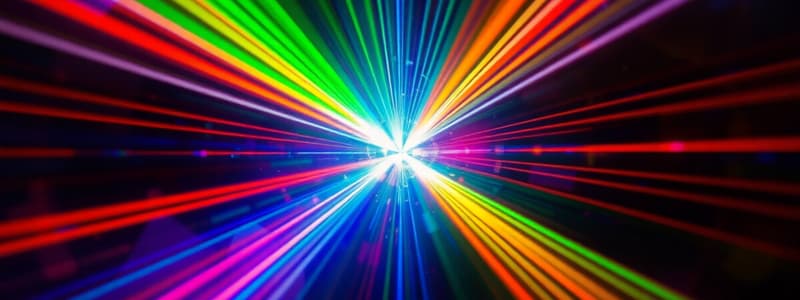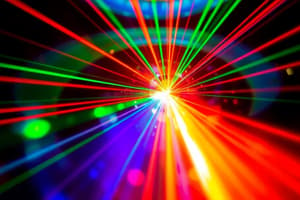Podcast
Questions and Answers
What is the far-field pattern obtained by observing?
What is the far-field pattern obtained by observing?
- The emitted pattern on a screen 2 cm away
- The emitted pattern in total darkness
- The emitted pattern on a screen 11 cm away (correct)
- The emitted pattern in direct sunlight
Which type of photodiode works in reverse bias?
Which type of photodiode works in reverse bias?
- Zener diode
- Avalanche Photodiode (APD)
- p-i-n photodiode (correct)
- p-n photodiode
What is the condition of current in a photodiode when no light is incident?
What is the condition of current in a photodiode when no light is incident?
- It increases proportionally with distance
- It is called the dark current (correct)
- It remains unchanged regardless of light
- It generates high voltage
What is measured when light is incident on a p-i-n photodiode?
What is measured when light is incident on a p-i-n photodiode?
Which characteristic is used to characterize the optical detector?
Which characteristic is used to characterize the optical detector?
What is a requirement for optical fiber connectors?
What is a requirement for optical fiber connectors?
Which of the following best describes the structure of most optical connectors?
Which of the following best describes the structure of most optical connectors?
Which voltage is applied while testing an Avalanche Photodiode (APD)?
Which voltage is applied while testing an Avalanche Photodiode (APD)?
Which connector type typically has an insertion loss of approximately 1 dB?
Which connector type typically has an insertion loss of approximately 1 dB?
What is the primary function of a fusion splicer?
What is the primary function of a fusion splicer?
Which splicer method is specifically used for splicing ribbon fibers?
Which splicer method is specifically used for splicing ribbon fibers?
What aligns two fibers using an optical microscope in splicing?
What aligns two fibers using an optical microscope in splicing?
Which precaution should be taken to minimize bending losses?
Which precaution should be taken to minimize bending losses?
What is a common feature of most optical connectors?
What is a common feature of most optical connectors?
What should be done to the fiber ends before splicing?
What should be done to the fiber ends before splicing?
Which of the following connector types is NOT mentioned as a common connector type?
Which of the following connector types is NOT mentioned as a common connector type?
What does LASER stand for?
What does LASER stand for?
What is the primary use of semiconductor lasers?
What is the primary use of semiconductor lasers?
In the context of laser operation, what is population inversion?
In the context of laser operation, what is population inversion?
Which of the following accurately describes stimulated emission in a laser?
Which of the following accurately describes stimulated emission in a laser?
What happens when the current applied to a semiconductor laser exceeds the threshold current?
What happens when the current applied to a semiconductor laser exceeds the threshold current?
What role do mirrors play in a laser's optical cavity?
What role do mirrors play in a laser's optical cavity?
What type of materials are typically used in semiconductor lasers?
What type of materials are typically used in semiconductor lasers?
Which type of emission occurs first when an atom absorbs energy?
Which type of emission occurs first when an atom absorbs energy?
Study Notes
Laser Characteristics
- LASERS stand for Light Amplification by Stimulated Emission of Radiation.
- Lasers are light amplifying devices, but they are difficult to use as pure amplifiers.
- Lasers are mainly used as optical oscillators.
- Semiconductor lasers are the most popular type of laser due to their low power, small size, and affordability.
- Semiconductor lasers are also known as injection lasers or laser diodes.
- They are made using heavily doped p+-n+ junction direct band gap materials.
- Semiconductor lasers typically operate in the infrared region.
- To achieve optical light amplification, more atoms must be in the higher energy level (E2) than the lower energy level (E1).
- This condition is known as population inversion.
- The optical cavity of a laser is formed using a pair of mirrors, one of which reflects the light, and the other allows some light to escape as the laser beam.
- The emitted photons in a laser have similar phase and polarization, ensuring coherence.
Semiconductor Laser (Laser Diode LD)
- Semiconductor lasers operate based on the same principle as general lasers.
- The mirror structure is formed by cleaving the semiconductor crystal plane, creating a Fabry-Perot resonator.
- When forward-biased, both spontaneous and stimulated emission occur in semiconductor lasers.
- When the current applied exceeds the threshold current, a high coherent beam of light is emitted.
- The characteristics of a laser diode are observed using a power meter and a current meter.
- Spatial emission characteristics are measured by observing the emitted pattern on a diffusing screen at different distances from the diode.
- Spectral characteristics are obtained by plotting power vs current characteristics while maintaining a fixed bias voltage.
Optical Detector
- Optical detectors are devices that detect light.
- They are classified into two types based on internal gain:
- Without Internal Gain:
- p-n photodiode
- p-i-n photodiode
- With Internal Gain:
- Avalanche Photodiode (APD)
- Without Internal Gain:
- p-i-n photodiodes operate in reverse bias.
- The current generated in a reverse-biased p-i-n photodiode is due to both thermally-generated minority carriers and photo-generated carriers.
- The reverse-biased current is proportional to the light intensity.
- A photodiode circuit typically consists of a photodiode connected to a resistance and two voltmeters.
- The current is measured using an ammeter.
- The current flowing in the circuit when no light is incident is called the dark current.
- When light is incident, the current varies with the light intensity.
Study of Different Connectors
- Optical fiber connectors are developed to meet various requirements in optical fiber communication.
- Connectors should be easily attached, have low cost, and low loss.
- Connectors are usually plug-like in structure and designed to align two optical fibers.
- Common connector types include:
- ST
- SC
- SMA
- FCD
- FC
- D4
- DIN
- Biconic
- Connectors are typically pre-attached to the fiber end, but some are available separately and need to be attached on-site.
- The insertion loss of a connector is typically 1 dB per connector.
Splice Available Optical Fiber
- Splicing is used to permanently join two optical fibers.
- There are two types of splicers:
- Fusion Splicer: permanently fuses two fibers by applying an electric arc.
- Mechanical Splicer: aligns two fibers using epoxy resin or V-groove.
- Fusion splicing is commonly used for fiber optic splicing in OSP and premises, compatible with single-mode and multimode fibers.
- Two types of core alignment are used in fusion splicing:
- Core alignment (uses optical microscope)
- Cladding alignment (uses stationary V-grooves)
- Mechanical splicing is often used for splicing ribbon fibers.
Studying That Suits You
Use AI to generate personalized quizzes and flashcards to suit your learning preferences.
Related Documents
Description
This quiz explores the fundamental concepts of lasers, including their definitions, types, and operational principles. Key topics such as semiconductor lasers, population inversion, and the optical cavity are covered to enhance understanding of this technology. Test your knowledge on how lasers amplify light and their common uses.




